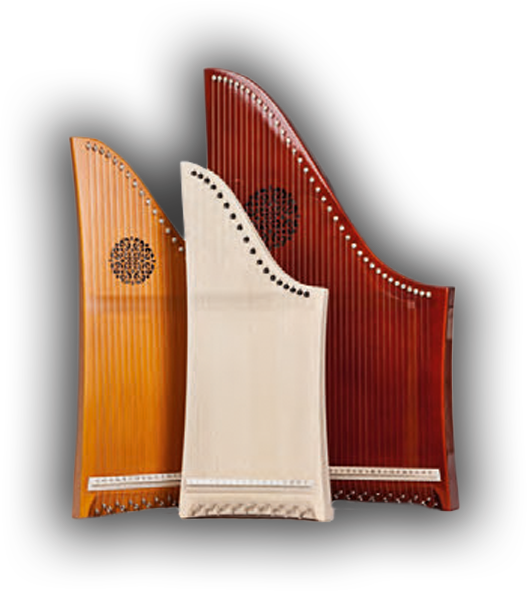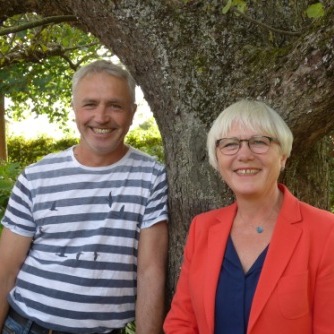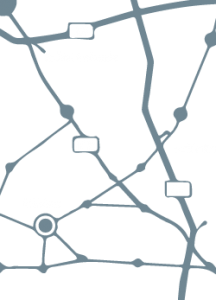Everything revolves around the harp
The company is still located at the place where the Veeh-Harfe was developed by Hermann Veeh, in Gülchsheim.
Since 1987 everything on his farm has revolved around the Veeh-Harfe. The farm has become a small craft business. Hermann Veeh’s children, Johanna Veeh-Krauss and Martin Veeh, run the family business, in which 15 employees work today. It is important to continue the life’s work of the father, because one can experience every day how much joy and fulfillment the Veeh-Harfe brings people.
The makers
As a master craftsman, Martin Veeh is responsible for the manufacture of the instruments.
Johanna Veeh-Krauß is a social educator and, as a business economist (HWK), is responsible for sales and management.
The whole team
Together we are the “Veeh-Harfe makers”: The employees in the workshop, in the publishing house and in sales.
“Die Veeh-Harfen-Macher” is the subtitle of a film by Hartwig Heinze, who looked over our shoulders for a few days while working with the camera and accompanied the story of its creation attentively and lovingly from the start.
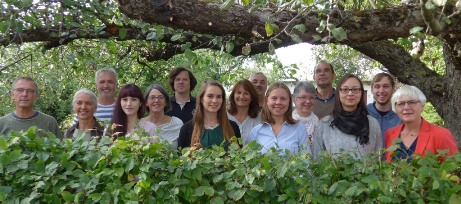
Head office
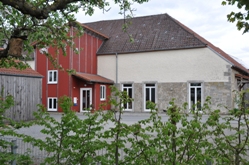
The company headquarters are still located on Hermann Veeh’s farm in Gülchsheim . The Veeh-Harfe should continue to be built where it originated and the existing buildings should be used. The stable and barn offered space for development.
In 2002/2003, the existing workshop in the former stable was expanded to include a large, bright, multifunctional room for events, sales and dispatch. In 2006 an office area was created. The barn serves as a warehouse and in summer as a hall for the court concert.
When the workshop became too small, especially due to the establishment of its own paint shop, production moved to the 2 km away in March 2011 Oellingen around.
All instruments are then strung in Gülchsheim and from here they travel to our customers. Many harp friends come to us because they want to see where the Veeh-Harfe comes from and of course to choose their own instrument. The sale still takes place exclusively in Gülchsheim and we look forward to your visit.
Hermann Veeh GmbH & Co.KG Phone: 09335 99 71 952 E-Mail: info@hermann-veeh.de |
Monday - Thursday 9:00 a.m. - 5:00 p.m. Please make an appointment so that we can take enough time for you. |
The workshop
From the trunk to the sound – a long way
Many steps are required before a tree becomes a Veeh-Harfe. When you consider that it takes almost 100 years for a tree to be strong enough for a Veeh-Harfe, you are in awe of the material wood. Not every tree is suitable to become a musical instrument: it has grown slowly at great heights, no bad event may disturb the direction of growth of the tree, no branch should cross the annual rings – then carefully felled and brought down to the valley.
The trunk is slowly dried and professionally cut. Joined in a mirror image, the wood finally reaches us. This is called solid tonewood. We use almost exclusively European woods: maple for the back and sides and spruce for the top. These woods have proven themselves in instrument making – especially in violin making.

At the beginning there is the selection of the wood. This is where it is decided which model will be made of it: with rosette, with mosaic ring, painted or oiled and waxed. Particularly beautiful wood is rare and is saved for exclusive instruments. Ultimately, all wooden parts should fit into a harmonious whole. Don’t forget the sound hole, it’s a must! Every harp has that on the back. When the blank is assembled, the edges are milled and sanded. After all, the harp should feel good and sit comfortably in the hand. The holes are drilled. 100 pieces are standard for one model – luckily there are templates! And now the surface. Of course: oiled and waxed or lacquered: semi-gloss or glossy – and what color?
Regardless of the surface, it takes time and many intermediate steps are required: oiling, waxing, priming, painting, drying, sanding again and again and finally polishing. The more elegant the surface, the more complex and risky the process. Finally the pegs are pressed into the peg block and the instruments can be strung. The bridge and the bridge are attached, the strings are threaded and pulled up. Then you vote – several times before the harp goes on sale. Every instrument is numbered and personalized – and every harp bears the brand: Original Veeh harp.

Showroom
Lots of instruments and a touch of history
A very large selection of Veeh harps and all accessories awaits you in the showroom in Gülchsheim. You will find Veeh-Harfe from the classic entry-level instrument to the exceptionally valuable one-offs. All instruments are ready to be played and our staff will be happy to show you everything. In the room next door, the harps are strung and made ready for shipping. Also a look into the barn, in which in summer the Court concert takes place is possible. On some weekends we use the sales exhibition as a space for Events . You can also find out more about the development of the Veeh-Harfe by Hermann Veeh here. The prototypes of the Veeh-Harfe are exhibited in several showcases and the steps required to create the final model are described. Until old age Hermann Veeh was here with his instruments every day and let visitors participate in his thoughts.
